technical specifications FIAT PUNTO 2021 Owner handbook (in English)
[x] Cancel search | Manufacturer: FIAT, Model Year: 2021, Model line: PUNTO, Model: FIAT PUNTO 2021Pages: 219, PDF Size: 9.82 MB
Page 98 of 219

PRETENSIONERS
To increase the efficiency of the seat belts,
the car is fitted with front pretensioners.
These devices, in the event of a violent
crash, rewind the seat belts by a few cen-
timetres. In this way, they ensure that the
seat belt adheres perfectly to the wearer
before the restraining action begins.
The seat belt reel locks to indicate that the
pretensioners have intervened; the seat
belt cannot be drawn back up even when
guiding it manually.
IMPORTANT To obtain the highest de-
gree of protection from the action of the
pretensioning device, wear the seat belt
tight to the chest and pelvis.
A slight amount of smoke may be detect-
ed during operation of the pretensioners.
This smoke is not harmful and does not
indicate a fire.
The pretensioner does not require any
maintenance or lubrication.
Anything that modifies its original condi-
tions invalidates its efficiency.
If, due to unusual natural events (floods,
sea storms, etc.), the device has been
affected by water and mud, it must be
replaced.LOAD LIMITERS
To increase passenger safety, the front
seat belt reels contain a load limiter which
controls the force acting on the chest and
shoulders during the belt restraining ac-
tion in the event of a head-on collision.
94
STARTING
AND DRIVING
WARNING
LIGHTS AND MESSAGES
IN AN
EMERGENCY
SERVICE
AND CARE
TECHNICAL
SPECIFICATIONS
INDEX
CONTROLS
AND DEVICES
SAFETY
The pretensioner can be
used only once. Go to a Fiat
Dealership to have it replaced after
it has been deployed.
WARNING
Operations which lead to
knocks, vibrations or lo-
calised heating (over 100 °C
for a maximum of 6 hours) in
the area around the pretensioners may
cause damage or trigger them. Contact
a Fiat Dealership for any assistance.
091-110 PUNTO POP 1ed EN 27/03/14 12:02 Pagina 94
Page 99 of 219
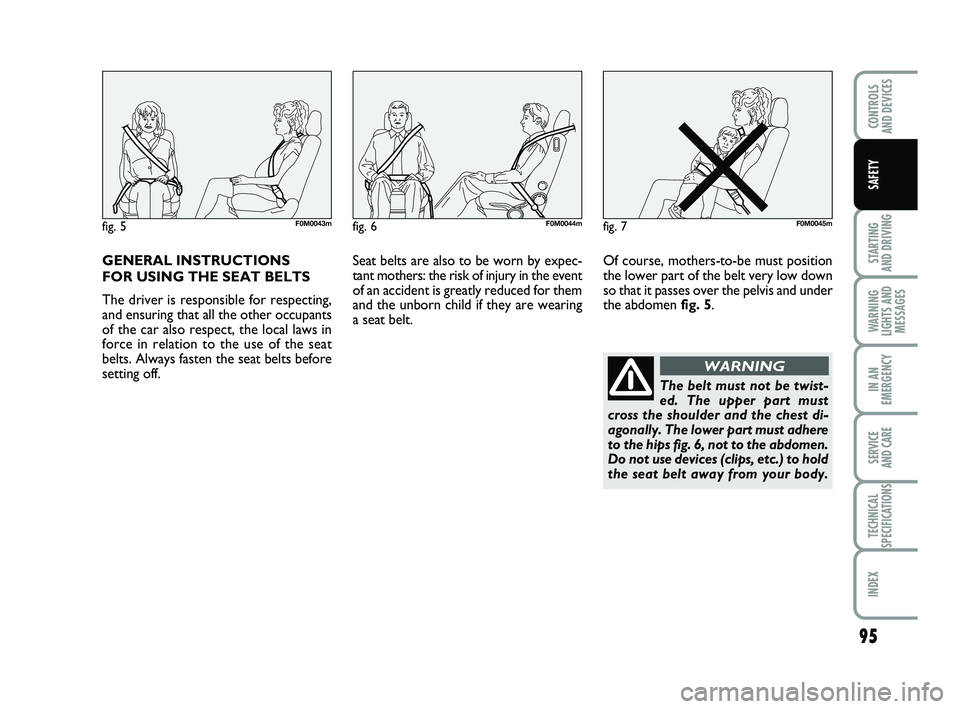
GENERAL INSTRUCTIONS
FOR USING THE SEAT BELTS
The driver is responsible for respecting,
and ensuring that all the other occupants
of the car also respect, the local laws in
force in relation to the use of the seat
belts. Always fasten the seat belts before
setting off.Seat belts are also to be worn by expec-
tant mothers: the risk of injury in the event
of an accident is greatly reduced for them
and the unborn child if they are wearing
a seat belt.
Of course, mothers-to-be must position
the lower part of the belt very low down
so that it passes over the pelvis and under
the abdomen fig. 5
.
95
STARTING
AND DRIVING
WARNING
LIGHTS AND MESSAGES
IN AN
EMERGENCY
SERVICE
AND CARE
TECHNICAL
SPECIFICATIONS
INDEX
CONTROLS
AND DEVICES
SAFETY
fig. 5F0M0043mfig. 6F0M0044mfig. 7F0M0045m
The belt must not be twist-
ed. The upper part must
cross the shoulder and the chest di-
agonally. The lower part must adhere
to the hips fig. 6, not to the abdomen.
Do not use devices (clips, etc.) to hold
the seat belt away from your body.
WARNING
091-110 PUNTO POP 1ed EN 27/03/14 12:02 Pagina 95
Page 100 of 219

HOW TO KEEP THE SEAT
BELTS EFFECTIVE
Observe the following precautions for
correct seat belt maintenance:
❒always use the belt with the tap wellstretched and never twisted; make sure
that it is free to run without obstruc-
tions;
❒replace the belt after a serious accident,even if it does not appear damaged.
Always replace the seat belt if the pre-
tensioners were deployed;
❒To clean the belt, wash by hand withwater and mild soap, rinse and leave to
dry in the shade. Do not use strong de-
tergents, bleach, paints or any other
chemicals which could damage the belt
fibres;
❒prevent the reels from getting wet:their correct operation is guaranteed
only if water does not get inside;
❒replace the seat belt when it showssigns of significant wear or cuts.
96
STARTING
AND DRIVING
WARNING
LIGHTS AND MESSAGES
IN AN
EMERGENCY
SERVICE
AND CARE
TECHNICAL
SPECIFICATIONS
INDEX
CONTROLS
AND DEVICES
SAFETY
For maximum safety, keep
the back of your seat up-
right, lean back into it and make sure
the seat belt fits closely across your
chest and hips. Always fasten the seat
belts on both the front and the rear
seats! Travelling without seat belts
will increase the risk of severe injury
and even death in the event of an
accident.
WARNING
Never disassemble or tamper
with the seat belt or preten-
sioner components. All operations
must be performed by qualified and
authorised personnel. Always go to
a Fiat Dealership.
WARNING
If the belt has been subject-
ed to heavy stress, for ex-
ample after an accident, it should be
changed completely together with
the anchors, anchor fastening screws
and the pretensioner. In fact, even if
the belt has no visible defects, it could
have lost its resilience.
WARNING
Each seat belt must be used
by only one person. Never
travel with a child sitting on the pas-
senger’s lap and a single belt to pro-
tect them both. In general, do not
place any objects between the person
and the belt.
WARNING
091-110 PUNTO POP 1ed EN 27/03/14 12:02 Pagina 96
Page 101 of 219
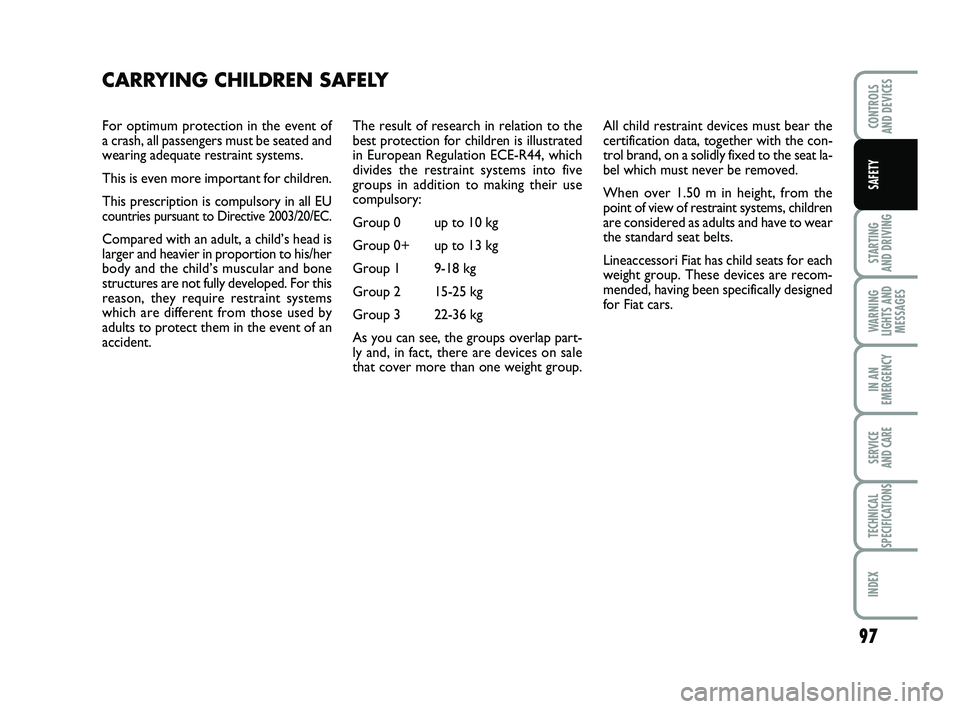
97
STARTING
AND DRIVING
WARNING
LIGHTS AND MESSAGES
IN AN
EMERGENCY
SERVICE
AND CARE
TECHNICAL
SPECIFICATIONS
INDEX
CONTROLS
AND DEVICES
SAFETY
For optimum protection in the event of
a crash, all passengers must be seated and
wearing adequate restraint systems.
This is even more important for children.
This prescription is compulsory in all EU
countries pursuant to Directive 2003/20/EC.
Compared with an adult, a child’s head is
larger and heavier in proportion to his/her
body and the child’s muscular and bone
structures are not fully developed. For this
reason, they require restraint systems
which are different from those used by
adults to protect them in the event of an
accident. The result of research in relation to the
best protection for children is illustrated
in European Regulation ECE-R44, which
divides the restraint systems into five
groups in addition to making their use
compulsory:
Group 0 up to 10 kg
Group 0+ up to 13 kg
Group 1 9-18 kg
Group 2 15-25 kg
Group 3 22-36 kg
As you can see, the groups overlap part-
ly and, in fact, there are devices on sale
that cover more than one weight group.
CARRYING CHILDREN SAFELY
All child restraint devices must bear the
certification data, together with the con-
trol brand, on a solidly fixed to the seat la-
bel which must never be removed.
When over 1.50 m in height, from the
point of view of restraint systems, children
are considered as adults and have to wear
the standard seat belts.
Lineaccessori Fiat has child seats for each
weight group. These devices are recom-
mended, having been specifically designed
for Fiat cars.
091-110 PUNTO POP 1ed EN 27/03/14 12:02 Pagina 97
Page 102 of 219
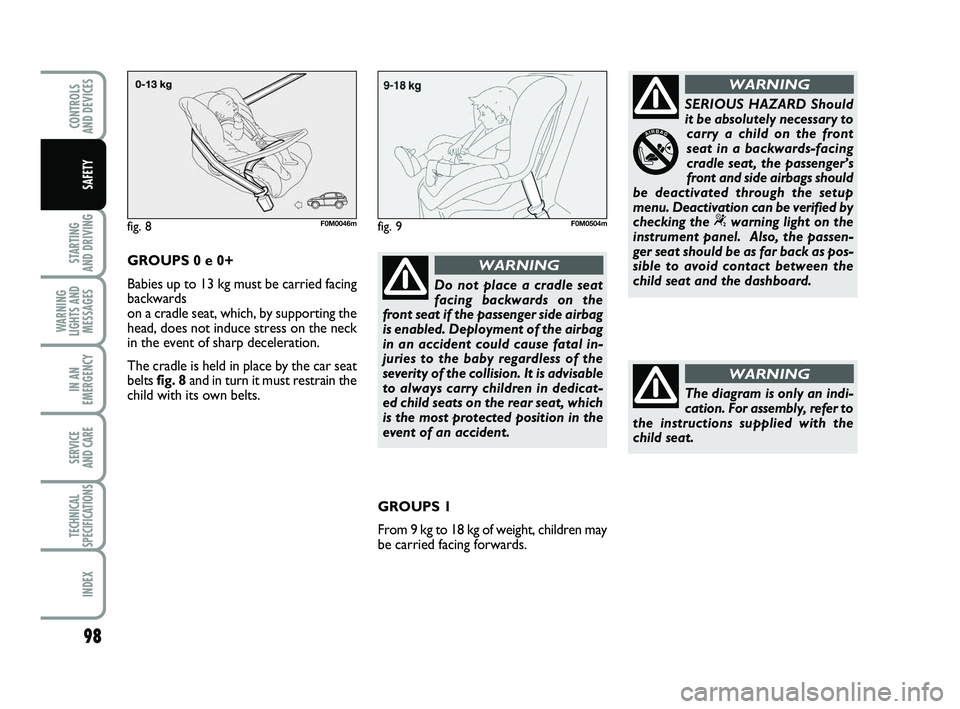
98
STARTING
AND DRIVING
WARNING
LIGHTS AND MESSAGES
IN AN
EMERGENCY
SERVICE
AND CARE
TECHNICAL
SPECIFICATIONS
INDEX
CONTROLS
AND DEVICES
SAFETY
Do not place a cradle seat
facing backwards on the
front seat if the passenger side airbag
is enabled. Deployment of the airbag
in an accident could cause fatal in-
juries to the baby regardless of the
severity of the collision. It is advisable
to always carry children in dedicat-
ed child seats on the rear seat, which
is the most protected position in the
event of an accident.
WARNING
SERIOUS HAZARD Should
it be absolutely necessary to carry a child on the front
seat in a backwards-facing
cradle seat, the passenger’s
front and side airbags should
be deactivated through the setup
menu. Deactivation can be verified by
checking the
“warning light on the
instrument panel. Also, the passen-
ger seat should be as far back as pos-
sible to avoid contact between the
child seat and the dashboard.
WARNING
fig. 8F0M0046mfig. 9F0M0504m
The diagram is only an indi-
cation. For assembly, refer to
the instructions supplied with the
child seat.
WARNING
GROUPS 0 e 0+
Babies up to 13 kg must be carried facing
backwards
on a cradle seat, which, by supporting the
head, does not induce stress on the neck
in the event of sharp deceleration.
The cradle is held in place by the car seat
belts fig. 8 and in turn it must restrain the
child with its own belts.
GROUPS 1
From 9 kg to 18 kg of weight, children may
be carried facing forwards.
091-110 PUNTO POP 1ed EN 27/03/14 12:02 Pagina 98
Page 103 of 219
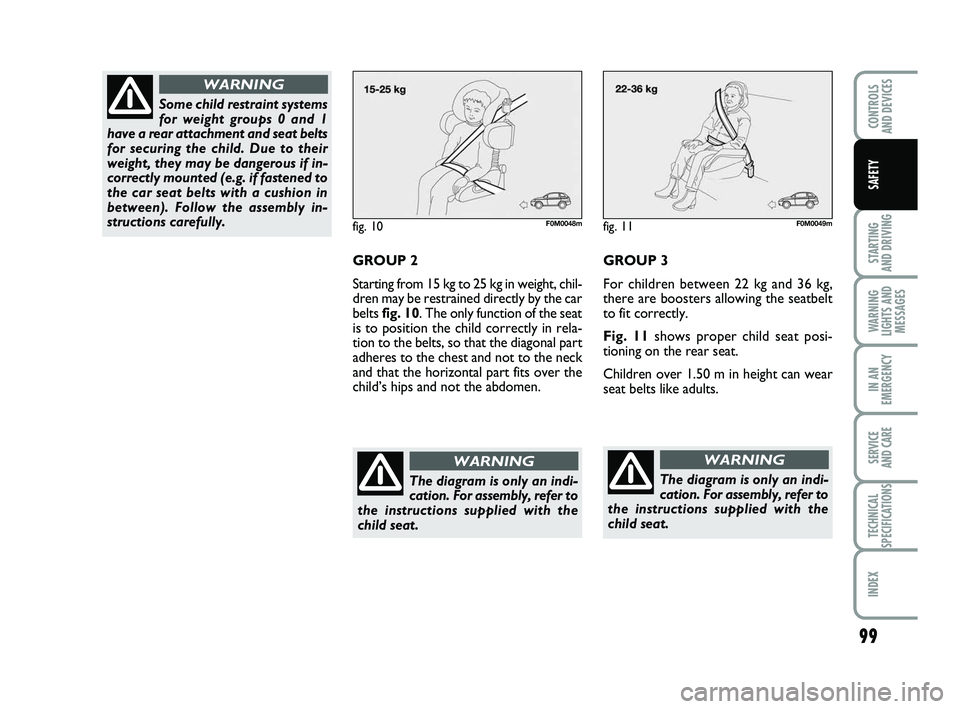
99
STARTING
AND DRIVING
WARNING
LIGHTS AND MESSAGES
IN AN
EMERGENCY
SERVICE
AND CARE
TECHNICAL
SPECIFICATIONS
INDEX
CONTROLS
AND DEVICES
SAFETY
fig. 10F0M0048m
GROUP 2
Starting from 15 kg to 25 kg in weight, chil-
dren may be restrained directly by the car
belts fig. 10. The only function of the seat
is to position the child correctly in rela-
tion to the belts, so that the diagonal part
adheres to the chest and not to the neck
and that the horizontal part fits over the
child’s hips and not the abdomen.
The diagram is only an indi-
cation. For assembly, refer to
the instructions supplied with the
child seat.
WARNING
Some child restraint systems
for weight groups 0 and 1
have a rear attachment and seat belts
for securing the child. Due to their
weight, they may be dangerous if in-
correctly mounted (e.g. if fastened to
the car seat belts with a cushion in
between). Follow the assembly in-
structions carefully.
WARNING
GROUP 3
For children between 22 kg and 36 kg,
there are boosters allowing the seatbelt
to fit correctly.
Fig. 11 shows proper child seat posi-
tioning on the rear seat.
Children over 1.50 m in height can wear
seat belts like adults.
fig. 11F0M0049m
The diagram is only an indi-
cation. For assembly, refer to
the instructions supplied with the
child seat.
WARNING
091-110 PUNTO POP 1ed EN 27/03/14 12:02 Pagina 99
Page 104 of 219
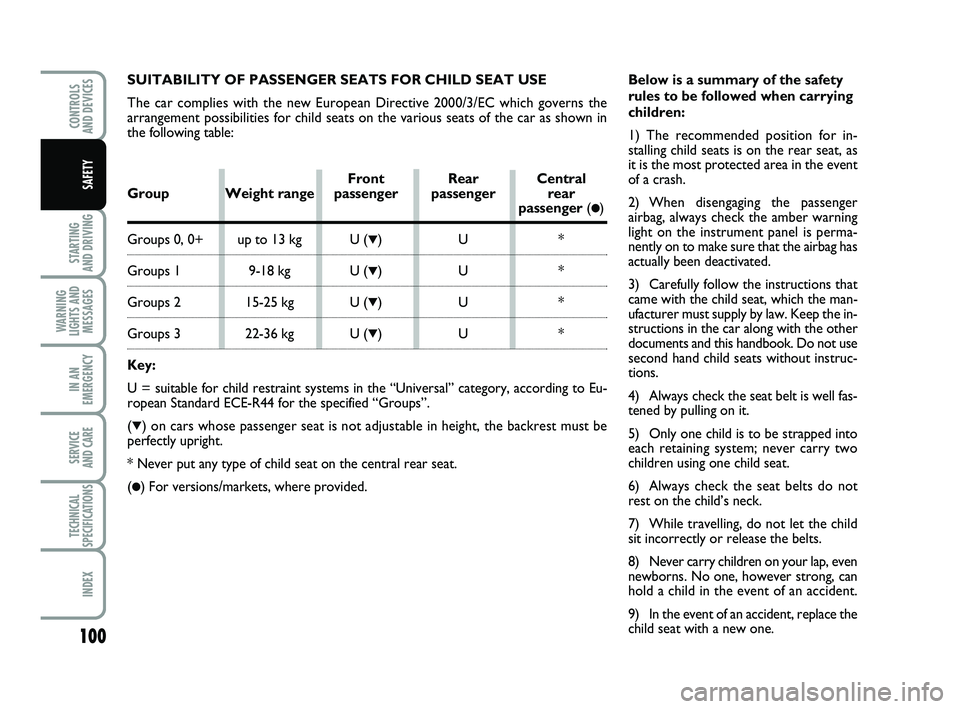
100
STARTING
AND DRIVING
WARNING
LIGHTS AND MESSAGES
IN AN
EMERGENCY
SERVICE
AND CARE
TECHNICAL
SPECIFICATIONS
INDEX
CONTROLS
AND DEVICES
SAFETY
SUITABILITY OF PASSENGER SEATS FOR CHILD SEAT USE
The car complies with the new European Directive 2000/3/EC which governs\
the
arrangement possibilities for child seats on the various seats of the ca\
r as shown in
the following table: Below is a summary of the safety
rules to be followed when carrying
children:
1) The recommended position for in-
stalling child seats is on the rear seat, as
it is the most protected area in the event
of a crash.
2) When disengaging the passenger
airbag, always check the amber warning
light on the instrument panel is perma-
nently on to make sure that the airbag has
actually been deactivated.
3) Carefully follow the instructions that
came with the child seat, which the man-
ufacturer must supply by law. Keep the in-
structions in the car along with the other
documents and this handbook. Do not use
second hand child seats without instruc-
tions.
4) Always check the seat belt is well fas-
tened by pulling on it.
5) Only one child is to be strapped into
each retaining system; never carry two
children using one child seat.
6) Always check the seat belts do not
rest on the child’s neck.
7) While travelling, do not let the child
sit incorrectly or release the belts.
8) Never carry children on your lap, even
newborns. No one, however strong, can
hold a child in the event of an accident.
9) In the event of an accident, replace the
child seat with a new one.
Front Rear Central
Group Weight range passenger passenger rear
passenger (●)
Groups 0, 0+ up to 13 kg U (▼)U *
Groups 1 9-18 kg U (▼)U *
Groups 2 15-25 kg U (▼)U *
Groups 3 22-36 kg U (▼)U *
Key:
U = suitable for child restraint systems in the “Universal” catego\
ry, according to Eu-
ropean Standard ECE-R44 for the specified “Groups”.
(
▼) on cars whose passenger seat is not adjustable in height, the backres\
t must be
perfectly upright.
* Never put any type of child seat on the central rear seat.
(
●) For versions/markets, where provided.
091-110 PUNTO POP 1ed EN 27/03/14 12:02 Pagina 100
Page 105 of 219
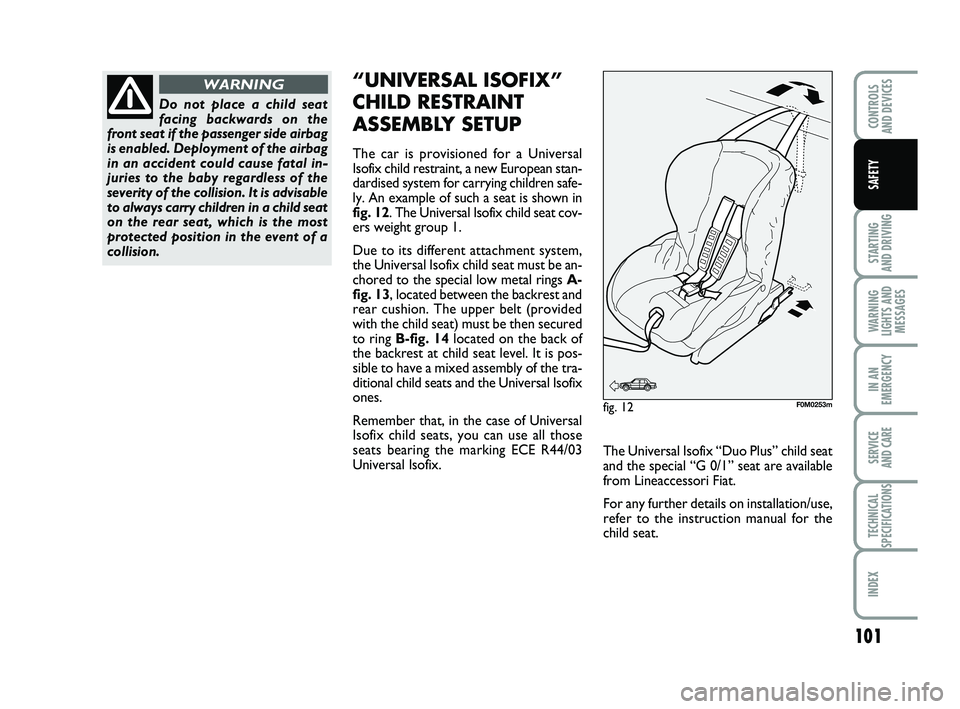
101
STARTING
AND DRIVING
WARNING
LIGHTS AND MESSAGES
IN AN
EMERGENCY
SERVICE
AND CARE
TECHNICAL
SPECIFICATIONS
INDEX
CONTROLS
AND DEVICES
SAFETY
Do not place a child seat
facing backwards on the
front seat if the passenger side airbag
is enabled. Deployment of the airbag
in an accident could cause fatal in-
juries to the baby regardless of the
severity of the collision. It is advisable
to always carry children in a child seat
on the rear seat, which is the most
protected position in the event of a
collision.
WARNING“UNIVERSAL ISOFIX”
CHILD RESTRAINT
ASSEMBLY SETUP
The car is provisioned for a Universal
Isofix child restraint, a new European stan-
dardised system for carrying children safe-
ly. An example of such a seat is shown in
fig. 12. The Universal Isofix child seat cov-
ers weight group 1.
Due to its different attachment system,
the Universal Isofix child seat must be an-
chored to the special low metal rings A-
fig. 13, located between the backrest and
rear cushion. The upper belt (provided
with the child seat) must be then secured
to ring B-fig. 14 located on the back of
the backrest at child seat level. It is pos-
sible to have a mixed assembly of the tra-
ditional child seats and the Universal Isofix
ones.
Remember that, in the case of Universal
Isofix child seats, you can use all those
seats bearing the marking ECE R44/03
Universal Isofix.
fig. 12F0M0253m
The Universal Isofix “Duo Plus” child seat
and the special “G 0/1” seat are available
from Lineaccessori Fiat.
For any further details on installation/use,
refer to the instruction manual for the
child seat.
091-110 PUNTO POP 1ed EN 27/03/14 12:02 Pagina 101
Page 106 of 219
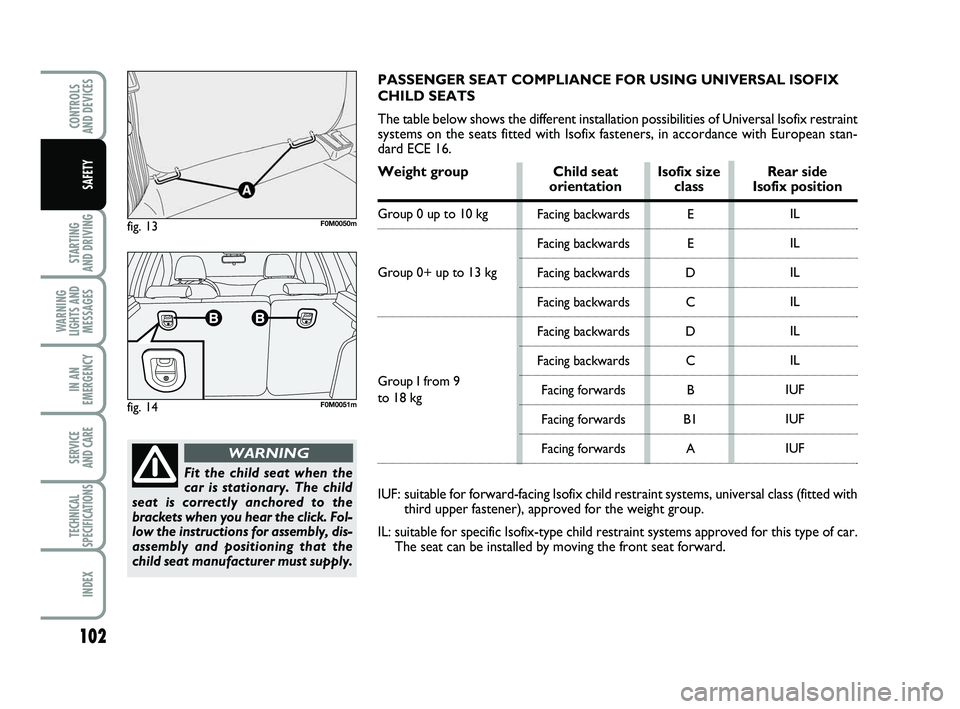
102
STARTING
AND DRIVING
WARNING
LIGHTS AND MESSAGES
IN AN
EMERGENCY
SERVICE
AND CARE
TECHNICAL
SPECIFICATIONS
INDEX
CONTROLS
AND DEVICES
SAFETY
fig. 13F0M0050m
fig. 14F0M0051m
Fit the child seat when the
car is stationary. The child
seat is correctly anchored to the
brackets when you hear the click. Fol-
low the instructions for assembly, dis-
assembly and positioning that the
child seat manufacturer must supply.
WARNING
E
E
D C
D C B
B1 A
PASSENGER SEAT COMPLIANCE FOR USING UNIVERSAL ISOFIX
CHILD SEATS
The table below shows the different installation possibilities of Univer\
sal Isofix restraint
systems on the seats fitted with Isofix fasteners, in accordance with Eu\
ropean stan-
dard ECE 16.
Weight group Child seat Isofix size Rear side
orientation class Isofix position
Group 0 up to 10 kg
Group 0+ up to 13 kg
Group I from 9
to 18 kg
IUF: suitable for forward-facing Isofix child restraint systems, universal cl\
ass (fitted with third upper fastener), approved for the weight group.
IL: suitable for specific Isofix-type child restraint systems approved for t\
his type of car. The seat can be installed by moving the front seat forward.
IL
IL
IL
IL
IL
IL
IUF
IUF
IUF
Facing backwards
Facing backwards
Facing backwards
Facing backwards
Facing backwards
Facing backwards
Facing forwards
Facing forwards
Facing forwards
091-110 PUNTO POP 1ed EN 27/03/14 12:02 Pagina 102
Page 107 of 219
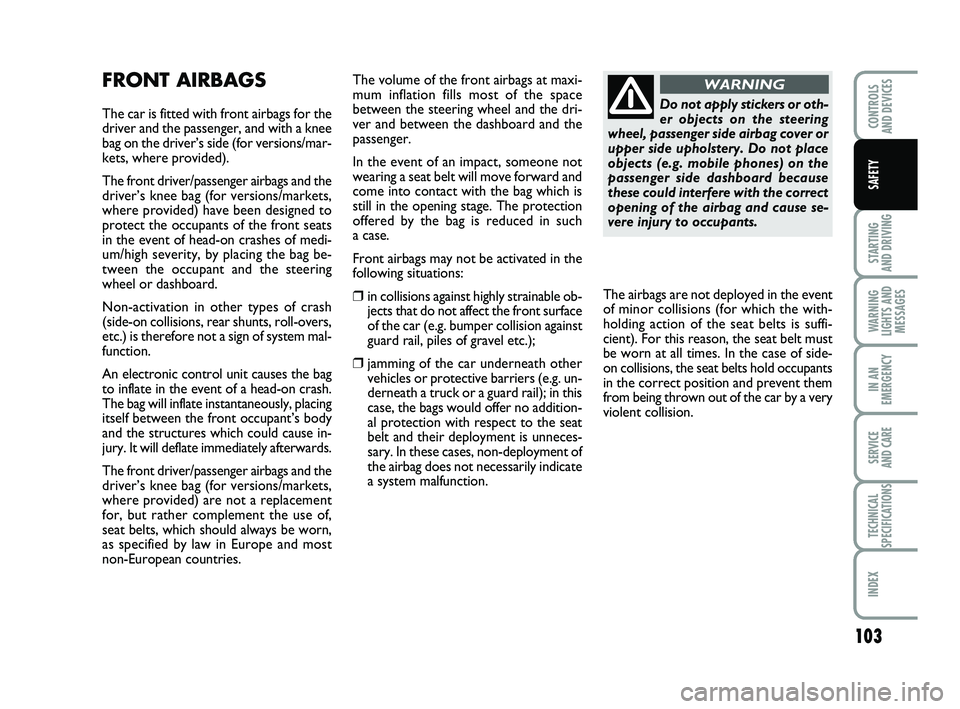
103
STARTING
AND DRIVING
WARNING
LIGHTS AND MESSAGES
IN AN
EMERGENCY
SERVICE
AND CARE
TECHNICAL
SPECIFICATIONS
INDEX
CONTROLS
AND DEVICES
SAFETY
FRONT AIRBAGS
The car is fitted with front airbags for the
driver and the passenger, and with a knee
bag on the driver’s side (for versions/mar -
kets, where provided).
The front driver/passenger airbags and the
driver’s knee bag (for versions/markets,
where provided) have been designed to
protect the occupants of the front seats
in the event of head-on crashes of medi-
um/high severity, by placing the bag be-
tween the occupant and the steering
wheel or dashboard.
Non-activation in other types of crash
(side-on collisions, rear shunts, roll-overs,
etc.) is therefore not a sign of system mal-
function.
An electronic control unit causes the bag
to inflate in the event of a head-on crash.
The bag will inflate instantaneously, placing
itself between the front occupant’s body
and the structures which could cause in-
jury. It will deflate immediately afterwards.
The front driver/passenger airbags and the
driver’s knee bag (for versions/markets,
where provided) are not a replacement
for, but rather complement the use of,
seat belts, which should always be worn,
as specified by law in Europe and most
non-European countries. The volume of the front airbags at maxi-
mum inflation fills most of the space
between the steering wheel and the dri-
ver and between the dashboard and the
passenger.
In the event of an impact, someone not
wearing a seat belt will move forward and
come into contact with the bag which is
still in the opening stage. The protection
offered by the bag is reduced in such
a case.
Front airbags may not be activated in the
following situations:
❒in collisions against highly strainable ob-
jects that do not affect the front surface
of the car (e.g. bumper collision against
guard rail, piles of gravel etc.);
❒jamming of the car underneath othervehicles or protective barriers (e.g. un-
derneath a truck or a guard rail); in this
case, the bags would offer no addition-
al protection with respect to the seat
belt and their deployment is unneces-
sary. In these cases, non-deployment of
the airbag does not necessarily indicate
a system malfunction.
Do not apply stickers or oth-
er objects on the steering
wheel, passenger side airbag cover or
upper side upholstery. Do not place
objects (e.g. mobile phones) on the
passenger side dashboard because
these could interfere with the correct
opening of the airbag and cause se-
vere injury to occupants.
WARNING
The airbags are not deployed in the event
of minor collisions (for which the with-
holding action of the seat belts is suffi-
cient). For this reason, the seat belt must
be worn at all times. In the case of side-
on collisions, the seat belts hold occupants
in the correct position and prevent them
from being thrown out of the car by a very
violent collision.
091-110 PUNTO POP 1ed EN 27/03/14 12:02 Pagina 103